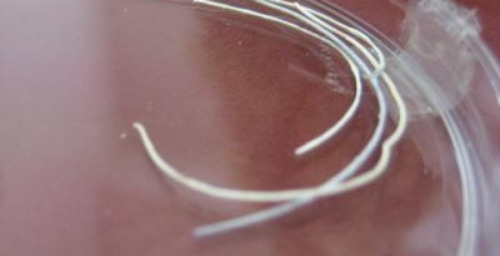New soluble fibers developed by an Israeli researcher have potential life-saving applications in wide-ranging areas – from burn victims to heart patients.

Small tubes called stents that are placed in the body to strengthen weakened and flabby arteries have saved the lives of thousands of people. Once the arteries are repaired, they’re no longer needed, but surgeons have had no choice but to leave them in – until now.
In a seemingly un-related development, a new wound dressing could dramatically cut the very large number of people with severe burns – 70 percent – who die as a result of related infections. A study published in the Journal of Biomedical Materials Research – Applied Biomaterials demonstrates that, after only two days, this dressing can eradicate infection-causing bacteria.
The connecting link between these two exciting medical developments is the new soluble fibers developed by Israeli Prof. Meital Zilberman of the Tel Aviv University (TAU) Department of Biomedical Engineering.
The fibers can be used to deliver infection-fighting antibiotics that dissolve when the job is done, and as coatings for biodegradable stents which dissolve after a pre-programmed period of time: “They combine strength with the desired elements necessary for drug delivery,” says Zilberman, so they can also “be used as the basis of biodegradable drug-eluting stents.”
A stent that does the work, then disappears
The applications of this novel technology multiply as fast as Zilberman can imagine them and she has also developed a bone growth scaffold derived from her basic research.
Zilberman’s patent-pending fiber platform carries drugs where they’re needed, then dissolves: “Our new composite fibers consist of a strong core coated with a drug-releasing, or ‘eluting,’ solution,” says Zilberman, adding that her unique coating technology can be used to coat both metal stents, which are currently available, and the biodegradable stents now in development.
“The main problem with drugs used on stents is that coating manufacturers have been unable to develop a method for releasing them in a controlled manner,” the professor explains. Insoluble in water, these drugs do not release well from a coating, however, a coating made from an extremely porous structure like hers provides a large surface area for diffusion. This gives heart specialists “a desired release profile.”
Pre-programmed to release the drugs in a controlled manner, Zilberman’s fibers can also be designed to dissolve within a precise number of months, so the stent can do its work, then disappear.
Mending cancers and brain tumors
She notes that her biodegradable drug-eluting fibers – only five times the thickness of a human hair – can also be applied in cancer treatments, particularly for cancers in hard to reach and sensitive areas such as in the brain, or in small children.
“When you take a tumor out of the brain, you can’t ‘clean’ the surrounding brain tissue – attempts to do so may lead to additional tissue damage. But if you left our biodegradable drug-loaded fiber in the brain, it could do the work, then disappear when it’s no longer needed,” she says.
And since the fibers are thin and delicate, Zilberman adds, laparoscopic methods can be used for their insertion, further increasing the chances for a full recovery.
So far, Zilberman and her Ph.D. student Amir Kraitzer have conducted biological experiments using an anti-cancer drug developed at TAU, and the results have been very encouraging.
Wound dressings packed with antibiotics
Despite advances in treatment regimens and the best efforts of nurses and doctors, about 70% of all people with severe burns die from related infections. Zilberman’s revolutionary new wound dressing could save many of those lives.
The new dressing protects the wound until it is no longer needed, after which it melts away. “We’ve developed the first wound dressing that both releases antibiotic drugs and biodegrades in a controlled manner,” says Zilberman. “It solves current mechanical and physical limitations in wound-dressing techniques and gives physicians a new and more effective platform for treating burns and bedsores.”
Zilberman is now starting the early stages of clinical trials on animal models. So far, her wound dressing has passed physical and mechanical tests in vitro and in bacterial inhibition tests in the laboratory.
While the concept is simple, the technology is not. Skin, Zilberman explains, serves a number of vastly different purposes. “Wound dressings must maintain a certain level of moisture while acting as a shield,” she says. “Like skin, they must also enable fluids from the wound to leave the infected tissue at a certain rate. It can’t be too fast or too slow. If too fast, the wound will dry out and it won’t heal properly. If too slow, there’s a real risk of increased contamination.”
Killing bacteria before they enter the body
The new wound dressing, which does not yet have a formal name, is designed to mimic skin and the way it protects the body. It combines positive mechanical and physical properties with what medical researchers call “a desired release profile of antibiotics.”
Unlike oral antibiotics, locally applied antibiotics can target and kill harmful bacteria before they enter the body to cause further infection, sepsis, or death. “People who suffer from large burns don’t usually die from the condition itself. The fatal culprits are the secondary bacterial infections that invade the body through these vulnerable burned areas,” Zilberman relates.
The new TAU dressing inhibits bacterial growth and is biodegradable, which helps doctors avoid constant wound cleaning and redressing, allowing the body to do the work on its own.
“When administered at the wound, a doctor can give relatively high but local doses of antibiotics, avoiding any toxicity issues that arise when the same amount of antibiotic passes through the body,” explains Zilberman, who worked on this research with Jonathan Elsner, her PhD student.
She is currently seeking a strategic partner to co-develop her research and take it to the commercial stage.












